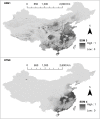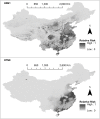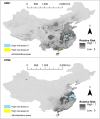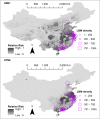Influenza A H5N1 and H7N9 in China: A spatial risk analysis
- PMID: 28376125
- PMCID: PMC5380336
- DOI: 10.1371/journal.pone.0174980
Influenza A H5N1 and H7N9 in China: A spatial risk analysis
Erratum in
-
Correction: Influenza A H5N1 and H7N9 in China: A spatial risk analysis.PLoS One. 2017 Apr 27;12(4):e0176903. doi: 10.1371/journal.pone.0176903. eCollection 2017. PLoS One. 2017. PMID: 28448630 Free PMC article.
Abstract
Background: Zoonotic avian influenza poses a major risk to China, and other parts of the world. H5N1 has remained endemic in China and globally for nearly two decades, and in 2013, a novel zoonotic influenza A subtype H7N9 emerged in China. This study aimed to improve upon our current understanding of the spreading mechanisms of H7N9 and H5N1 by generating spatial risk profiles for each of the two virus subtypes across mainland China.
Methods and findings: In this study, we (i) developed a refined data set of H5N1 and H7N9 locations with consideration of animal/animal environment case data, as well as spatial accuracy and precision; (ii) used this data set along with environmental variables to build species distribution models (SDMs) for each virus subtype in high resolution spatial units of 1km2 cells using Maxent; (iii) developed a risk modelling framework which integrated the results from the SDMs with human and chicken population variables, which was done to quantify the risk of zoonotic transmission; and (iv) identified areas at high risk of H5N1 and H7N9 transmission. We produced high performing SDMs (6 of 8 models with AUC > 0.9) for both H5N1 and H7N9. In all our SDMs, H7N9 consistently showed higher AUC results compared to H5N1, suggesting H7N9 suitability could be better explained by environmental variables. For both subtypes, high risk areas were primarily located in south-eastern China, with H5N1 distributions found to be more diffuse and extending more inland compared to H7N9.
Conclusions: We provide projections of our risk models to public health policy makers so that specific high risk areas can be targeted for control measures. We recommend comparing H5N1 and H7N9 prevalence rates and survivability in the natural environment to better understand the role of animal and environmental transmission in human infections.
Conflict of interest statement
Figures






References
-
- World Health Organization (WHO) (2016) Cumulative number of confirmed human cases of avian influenza A(H5N1) reported to WHO (19 July 2016).
-
- Food and Agricultural Organisation of the United Nations (FAO) (2016) H7N9 situation update—20 July 2016.
MeSH terms
LinkOut - more resources
Full Text Sources
Other Literature Sources
Medical

